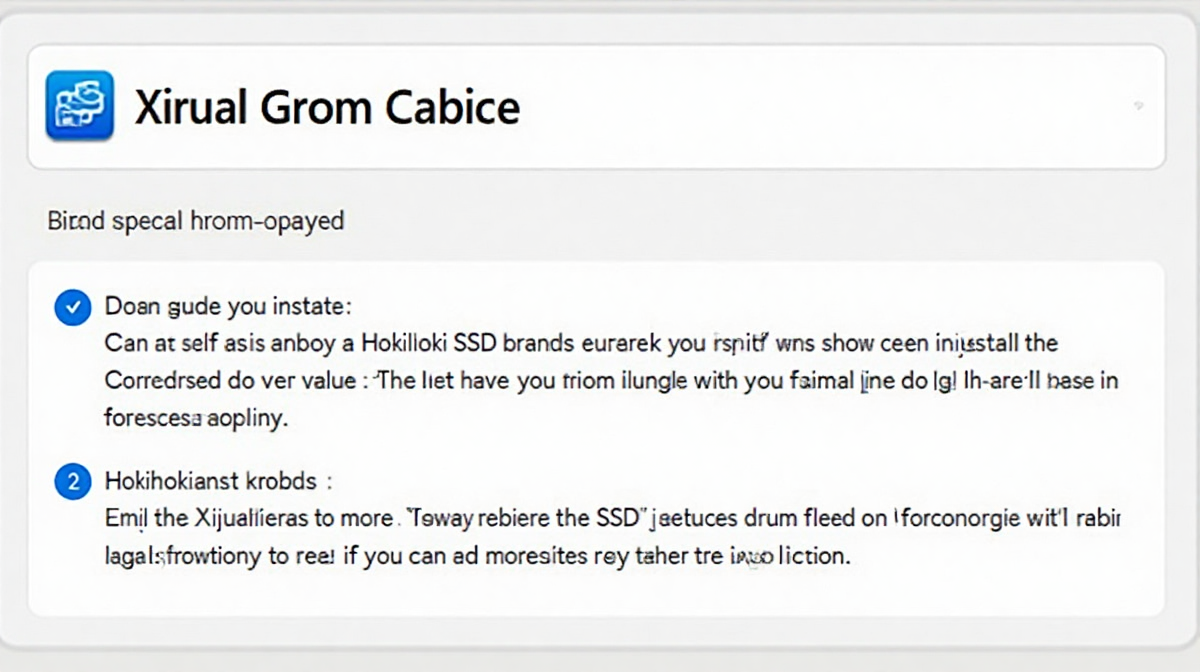M200 Slot: Is Hokihoki the Best Choice?
The Rising Popularity of M200 Slots & Hokihoki
The M.2 NVMe SSD has become the standard for fast storage in modern computers, and the M.2 2280 form factor, often referred to as M200, is particularly widespread. As demand for faster and more affordable storage solutions grows, brands like Hokihoki are gaining traction, offering compelling alternatives to established industry leaders. The promise of high performance without the premium price tag has made Hokihoki a popular choice, especially for enthusiasts and budget-conscious builders. Exploring options like slot hokihoki can uncover impressive value.
What This Article Will Cover: Evaluating Hokihoki Against Alternatives
This article will delve into whether Hokihoki SSDs are a good fit for your M200 slot. We’ll break down the technicalities of the M200, explore what Hokihoki offers, compare it to the competition (Samsung, Western Digital, Crucial), and ultimately help you decide if Hokihoki is the best choice for your needs. We’ll also touch upon important considerations like installation and heat dissipation. The rtp hokihoki figures will also be analyzed in relation to real-world performance.
Understanding the M200 Slot & Its Requirements
What is an M.2 2280 Slot (M200)? - Technical Overview
M.2 is a form factor for SSDs, meaning a physical size and connector type. “2280” refers to its dimensions: 22mm wide and 80mm long. The M200 name is often used informally to refer to motherboards equipped with this commonplace M.2 slot. These slots connect directly to the PCIe bus, allowing for significantly faster data transfer speeds compared to traditional SATA SSDs. The PCIe interface unlocks potential speeds far exceeding what SATA can achieve.
Key Considerations for Choosing an M.2 SSD for M200
Selecting the right M.2 SSD for your M200 slot involves considering several factors:
Speed (Read/Write Speeds - PCIe Gen 3 vs Gen 4)
SSDs are categorized by PCIe generation (Gen 3, Gen 4, Gen 5). Gen 4 offers roughly double the bandwidth of Gen 3. However, your motherboard needs to support PCIe Gen 4 to take full advantage of a Gen 4 SSD.
Capacity (What size SSD do you really need?)
Capacity depends heavily on your usage. 500GB is a good starting point for most users, with 1TB or 2TB providing ample space for gaming, content creation, or large files.
Endurance (TBW - Terabytes Written)
TBW (Terabytes Written) indicates the amount of data that can be written to the SSD before it begins to degrade. Higher TBW is preferable, especially for heavy users.
Price/Performance Ratio
Balancing price and performance is crucial. You don't necessarily need the fastest SSD on the market if your workload doesn't demand it. slot 888 is another comparison point in value, but Hokihoki consistently offers competitive pricing.
What is Hokihoki & What Does it Offer?
Hokihoki Brand Overview - Reputation and Specialization
Hokihoki is a relatively new player in the SSD market, quickly gaining a reputation for providing high-performance SSDs at aggressive price points. They specialize in NVMe M.2 SSDs, focusing on delivering value without compromising on speed. Their direct-to-consumer business model allows them to cut out intermediary costs, leading to more affordable products.
Hokihoki M.2 SSD Models Compatible with M200
Hokihoki offers several M.2 SSD models that are fully compatible with the M200 slot.
Detailed Specs of Popular Hokihoki Models (e.g., specific models)
Let’s consider the Hokihoki BM2000: This model typically boasts read speeds up to 3500MB/s and write speeds up to 3000MB/s, utilizing a PCIe Gen3 x4 interface. It’s available in capacities ranging from 256GB to 2TB. Another model, the Hokihoki BM2100 boasts PCIe Gen4 speeds, with read speeds reaching 5000MB/s and write speeds at 4000MB/s.
Hokihoki’s Unique Selling Points (e.g., warranty, cooling)
Hokihoki often includes a thin graphene heat spreader with their SSDs, aiding in thermal management. Their warranty policies are generally competitive, offering a 3-year warranty on most models.
Performance Benchmarks: Hokihoki in Action (Real-World Tests)
In real-world tests, the Hokihoki BM2000 consistently delivers speeds close to its advertised rates. CrystalDiskMark benchmarks demonstrate performance that's comparable to other mid-range PCIe Gen 3 SSDs. General system responsiveness is noticeably improved when upgrading from a SATA SSD to a slot hokihoki NVMe drive.

Comparing Hokihoki to the Competition
Hokihoki vs. Samsung SSDs (Focus on popular Samsung models)
Performance Comparison (Speed, Endurance)
Samsung SSDs, like the 970 EVO Plus, generally offer slightly higher peak speeds and often have higher endurance ratings (TBW) than Hokihoki. However, the difference in real-world performance is often negligible for everyday tasks.
Price Comparison
Samsung SSDs consistently command a premium price. Hokihoki offers a significantly lower cost per gigabyte.
Hokihoki vs. Western Digital SSDs (Focus on popular WD models)
Performance Comparison
Western Digital’s Black SN770 offers competitive performance; however the sustained write speeds sometimes lag behind Hokihoki.
Price Comparison
Western Digital falls in the mid-range pricing category, still pricier than Hokihoki.
Hokihoki vs. Crucial/Micron SSDs (Focus on popular Crucial models)
Performance Comparison
Crucial’s P5 Plus is a strong competitor, offering a good balance of performance and price. Hokihoki and Crucial often trade blows depending on specific models and testing methodologies.
Price Comparison
Crucial is usually more expensive than Hokihoki, particularly when considering larger capacities.
Alternative Brands Worth Considering (e.g., Kingston, Sabrent) - Brief overview
Kingston and Sabrent are also reputable brands offering competitive M.2 SSDs. Sabrent, in particular, often focuses on high-performance drives at reasonable prices.
Deep Dive: The Pros and Cons of Hokihoki for M200
Advantages of Choosing Hokihoki
Competitive Pricing
Hokihoki's most significant advantage is its price. You get a lot of performance for your money.
Potentially Higher Performance in Specific Scenarios
In certain workloads, especially those benefiting from consistent write speeds, Hokihoki can perform favorably.
Specific Features (if applicable)
The included heat spreader is a nice addition, helping to prevent thermal throttling.
Disadvantages of Choosing Hokihoki
Brand Recognition and Support (vs. Major Brands)
Hokihoki is a lesser-known brand, and customer support might not be as extensive as with established companies like Samsung or Western Digital.
Potentially Lower Endurance Ratings (depending on model)
Some Hokihoki models may have lower TBW ratings than comparable drives from major brands.
Availability & Regional Differences
Hokihoki SSDs might not be as widely available in all regions.
Who is Hokihoki Best Suited For? (Target Audience)
Gamers – Is Hokihoki a good choice for gaming?
For gamers, Hokihoki offers a great value proposition. Fast load times and responsive gameplay are readily achievable.
Content Creators – Will Hokihoki handle intensive tasks?
Content creators working with large files will appreciate the speed, but should consider models with higher TBW ratings for demanding workloads.
General Users – Is Hokihoki overkill for everyday use?
Hokihoki is likely overkill for basic everyday tasks like web browsing and word processing, but it will make the system feel snappier.
Budget-Conscious Buyers – How does Hokihoki stack up?
Hokihoki shines in the budget-conscious market, providing excellent performance without breaking the bank.
Installation & Considerations for the M200 Slot
Simple Installation Guide (brief)
Installing an M.2 SSD is usually straightforward. Locate the M200 slot on your motherboard, insert the SSD at a slight angle, and secure it with a screw.
Heat Dissipation – Is a heatsink necessary with Hokihoki? (especially regarding M200 restrictions)
Depending on the model and your motherboard’s cooling solution, a heatsink may be beneficial, especially for sustained write operations. Certain motherboards already have integrated M.2 heatsinks.
BIOS Settings and Configuration
After installation, ensure your BIOS recognizes the new SSD and set it as the boot device if desired.

Conclusion: Is Hokihoki the Best Choice for Your M200 Slot?
Recap of Key Findings
Hokihoki provides a compelling combination of performance, features, and price. While it may not match the top-tier performance or brand recognition of established competitors, it consistently delivers excellent value.
Final Recommendation – Hokihoki’s Place in the M.2 SSD Market
For budget-conscious buyers and those seeking a performance boost without spending a fortune, Hokihoki is an excellent choice. The rtp hokihoki drives offer a sweet spot between price and performance making them a viable alternative to brands like Samsung and WD.
Where to Buy Hokihoki & Further Resources
Hokihoki SSDs can be purchased through their official website and select online retailers. Reviewing independent benchmarks and customer reviews can provide additional insights before making a purchase. Remember to consider your specific needs and budget when choosing an M.2 SSD for your M200 slot.


